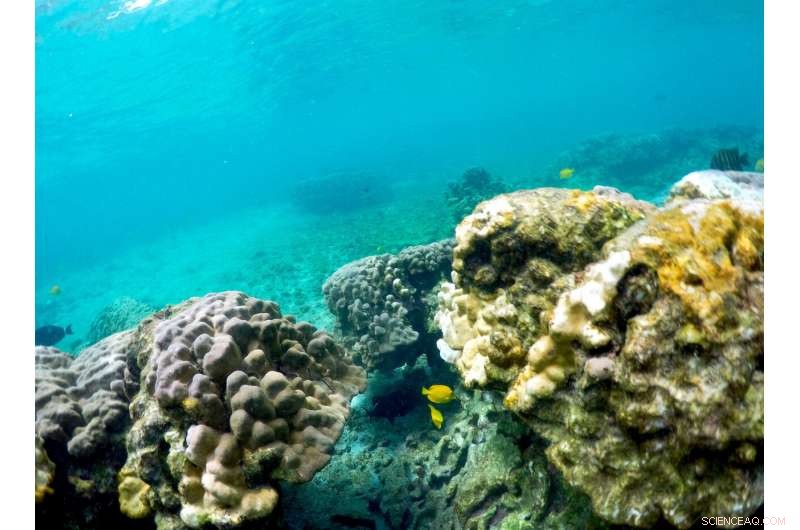
Denna 12 september, 2019 foto visar blekning av koraller i Kahala'u Bay i Kailua-Kona, Hawaii. Bara fyra år efter att en stor marin värmebölja dödade nästan hälften av denna kustlinjes koraller, federala forskare förutspår att ytterligare en omgång varmt vatten kommer att orsaka några av de värsta korallblekning som regionen någonsin har sett. (AP Photo/Caleb Jones)
Vid kanten av ett gammalt lavaflöde där taggiga svarta stenar möter Stilla havet, Små off-the-grid hem har utsikt över det lugna blå vattnet i Papa Bay på Hawaiis Big Island - inga turister eller hotell i sikte. Här, ett av öarnas rikligaste och mest livfulla korallrev frodas precis under ytan.
Ändå även denna avlägsna kustlinje långt ifrån effekterna av kemisk solkräm, trampande fötter och industriellt avloppsvatten visar tidiga tecken på vad som förväntas bli en katastrofal säsong för koraller på Hawaii.
Bara fyra år efter att en stor marin värmebölja dödade nästan hälften av denna kustlinjes koraller, federala forskare förutspår att ytterligare en omgång varmvatten kommer att orsaka några av de värsta korallblekning som regionen någonsin har upplevt.
"2015, vi nådde temperaturer som vi aldrig någonsin har registrerat på Hawaii, " sa Jamison Gove, en oceanograf med National Oceanic and Atmospheric Administration. "Vad är verkligen viktigt - eller alarmerande, förmodligen mer lämpligt – om denna händelse är att vi har spårat ovan var vi var vid den här tiden 2015."
Forskare som använder högteknologisk utrustning för att övervaka Hawaiis rev ser tidiga tecken på blekning i Papa Bay och på andra ställen orsakade av en marin värmebölja som har fått temperaturen att stiga till rekordnivåer i månader. juni, Juli och delar av augusti upplevde alla de hetaste havstemperaturerna som någonsin registrerats runt Hawaiiöarna. Hittills i september, Havstemperaturerna är bara lägre än de som sågs 2015.
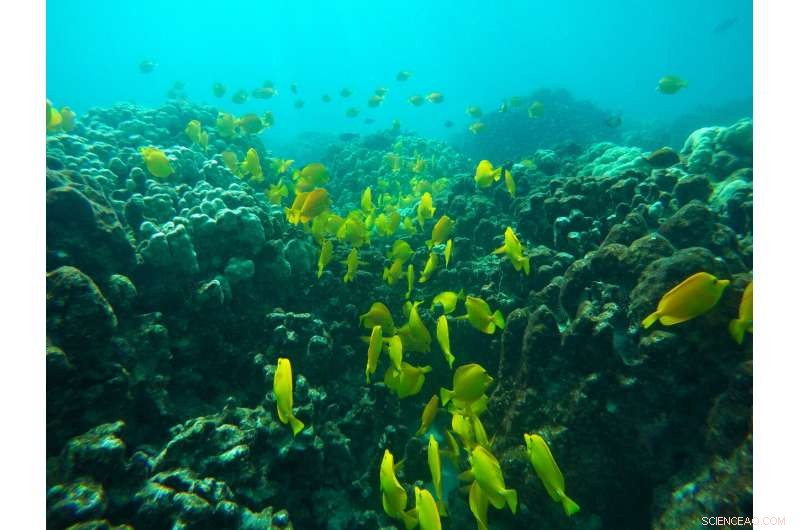
Denna 12 september, 2019 foto visar fisk nära koraller i en vik på västkusten av Big Island nära Captain Cook, Hawaii. Bara fyra år efter att en stor marin värmebölja dödade nästan hälften av denna kustlinjes koraller, federala forskare förutspår att ytterligare en omgång varmt vatten kommer att orsaka några av de värsta korallblekning som regionen någonsin har sett. (AP Photo/Brian Skoloff)
Prognosmakare förväntar sig att höga temperaturer i norra Stilla havet kommer att fortsätta pumpa värme till Hawaiis vatten långt in i oktober.
"Temperaturerna har varit varma ganska länge, " Sa Gove. "Det är inte bara hur varmt det är. Det är hur länge dessa havstemperaturer förblir varma."
Korallrev är livsviktiga runt om i världen eftersom de inte bara ger en livsmiljö för fisk – basen i den marina näringskedjan – utan också mat och medicin för människor. De skapar också en viktig strandbarriär som bryter isär stora havsdyningar och skyddar tätbefolkade kustlinjer från stormfloder under orkaner.
På Hawaii, Rev är också en viktig del av ekonomin:Turismen frodas till stor del på grund av korallrev som hjälper till att skapa och skydda ikoniska vita sandstränder, erbjuder snorklings- och dykplatser, och hjälpa till att bilda vågor som lockar surfare från hela världen.
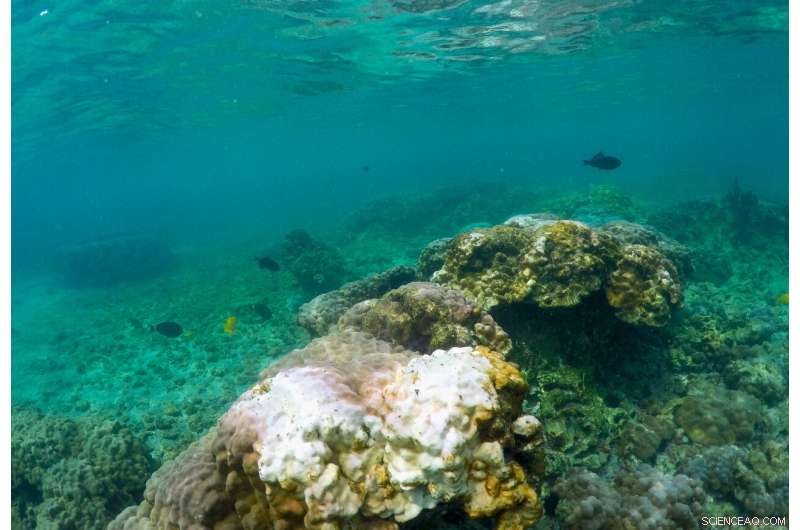
Denna 12 september, 2019 foto visar blekning av koraller i Kahala'u Bay i Kailua-Kona, Hawaii. Bara fyra år efter att en stor marin värmebölja dödade nästan hälften av denna kustlinjes koraller, federala forskare förutspår att ytterligare en omgång varmt vatten kommer att orsaka några av de värsta korallblekning som regionen någonsin har sett. (AP Photo/Caleb Jones)
Havstemperaturerna är inte jämnt varma över hela staten, Gove noterade. Lokala vindmönster, strömmar och även funktioner på land kan skapa heta punkter i vattnet.
"Du har saker som två gigantiska vulkaner på Big Island som blockerar de dominerande passadvindarna, "gör öns västkust, där Papa Bay sitter, en av de hetaste delarna av staten, sa Gove. Han sa att han förväntar sig "allvarlig" korallblekning på de platserna.
"Detta är utbrett, 100% blekning av de flesta koraller, " sa Gove. Och många av dessa koraller återhämtar sig fortfarande från blekningshändelsen 2015, vilket innebär att de är mer mottagliga för termisk stress.
Enligt NOAA, Värmeböljans orsaker inkluderar ett ihållande lågtrycksvädermönster mellan Hawaii och Alaska som har försvagat vindar som annars kan blandas och kyla ytvatten över stora delar av norra Stilla havet. Vad som orsakar det är oklart:Det kan återspegla atmosfärens vanliga kaotiska rörelse, eller det kan vara relaterat till uppvärmningen av haven och andra effekter av mänskligt skapade klimatförändringar.
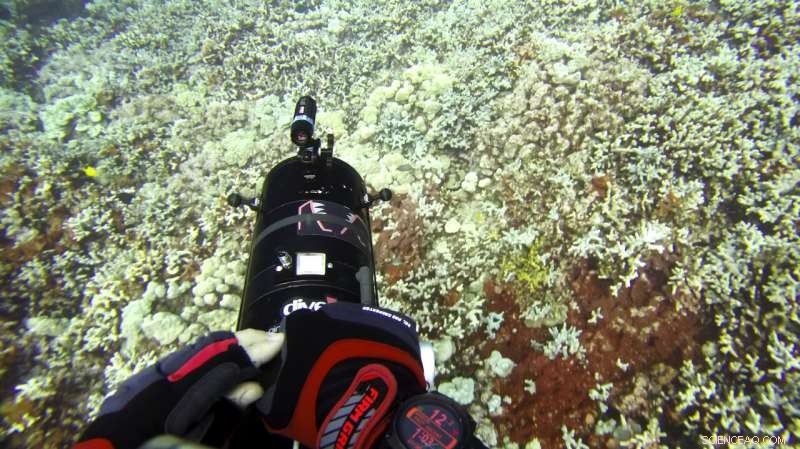
I denna 13 september, 2019 bild tagen från video från Arizona State Universitys Center for Global Discovery and Conservation Science, Ekologen Greg Asner dyker över ett korallrev i Papa Bay nära Captain Cook, Hawaii. "Nästan varje art som vi övervakar har åtminstone viss blekning, " sa Asner. (Greg Asner/Arizona State Universitys Center for Global Discovery and Conservation Science via AP)
Utöver detta evenemang, havets temperaturer kommer att fortsätta att stiga under de kommande åren, sa Gove. "There's no question that global climate change is contributing to what we're experiencing, " han sa.
For coral, hot water means stress, and prolonged stress kills these creatures and can leave reefs in shambles.
Bleaching occurs when stressed corals release algae that provide them with vital nutrients. That algae also gives the coral its color, so when it's expelled, the coral turns white.
Gove said researchers have a technological advantage for monitoring and gleaning insights into this year's bleaching, data that could help save reefs in the future.
"We're trying to track this event in real time via satellite, which is the first time that's ever been done, " Gove said.
In remote Papa Bay, most of the corals have recovered from the 2015 bleaching event, but scientists worry they won't fare as well this time.
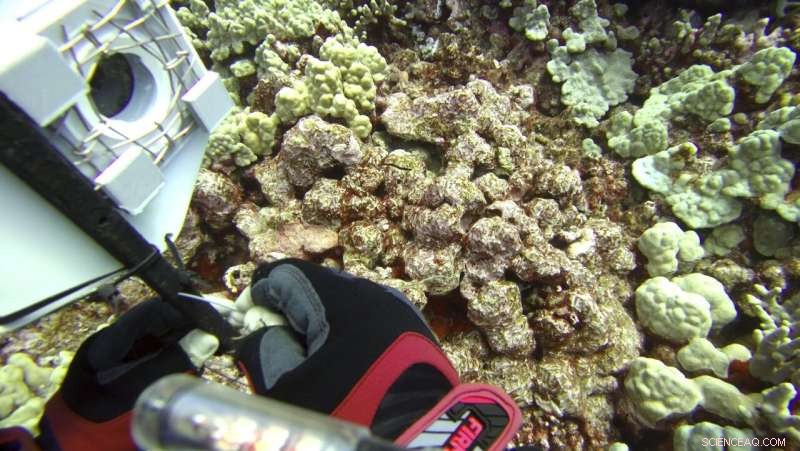
I denna 13 september, 2019, image taken from video provided by Arizona State University's Center for Global Discovery and Conservation Science, ecologist Greg Asner prepares a camera fish trap on a coral reef in Papa Bay near Captain Cook, Hawaii. "Nearly every species that we monitor has at least some bleaching, " Asner said. (Greg Asner/Arizona State University's Center for Global Discovery and Conservation Science via AP)
"Nearly every species that we monitor has at least some bleaching, " sa ekologen Greg Asner, director of Arizona State University's Center for Global Discovery and Conservation Science, after a dive in the bay earlier this month.
Asner told The Associated Press that sensors showed the bay was about 3.5 degrees Fahrenheit above what is normal for this time of year.
He uses advanced imaging technology mounted to aircrafts, satellitdata, underwater sensors and information from the public to give state and federal researchers like Gove the information they need.
"What's really important here is that we're taking these (underwater) measurements, connecting them to our aircraft data and then connecting them again to the satellite data, " Asner said. "That lets us scale up to see the big picture to get the truth about what's going on here."
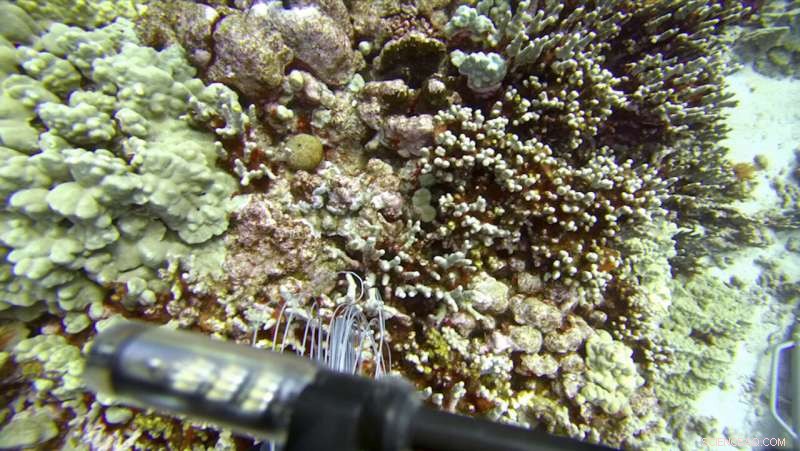
I denna 13 september, 2019 image taken from video provided by Arizona State University's Center for Global Discovery and Conservation Science, ecologist Greg Asner dives over a coral reef in Papa Bay near Captain Cook, Hawaii. "Nearly every species that we monitor has at least some bleaching, " Asner said. (Greg Asner/Arizona State University's Center for Global Discovery and Conservation Science via AP)
Scientists will use the information to research, bland annat, why some coral species are more resilient to thermal stress. Some of the latest research suggests slowly exposing coral to heat in labs can condition them to withstand hotter water in the future.
"After the heat wave ends, we will have a good map with which to plan restoration efforts, " Asner said.
Under tiden, Hawaii residents like Cindi Punihaole Kennedy are pitching in by volunteering to educate tourists. Punihaole Kennedy is director of the Kahalu'u Bay Education Center, a nonprofit created to help protect Kahalu'u Bay, a popular snorkeling spot near the Big Island's tourist center of Kailua-Kona.
The bay and surrounding beach park welcome more than 400, 000 visitors a year, Hon sa.
"We share with them what to do and what not to do as they enter the bay, " sa hon. "Till exempel, avoid stepping on the corals or feeding the fish."
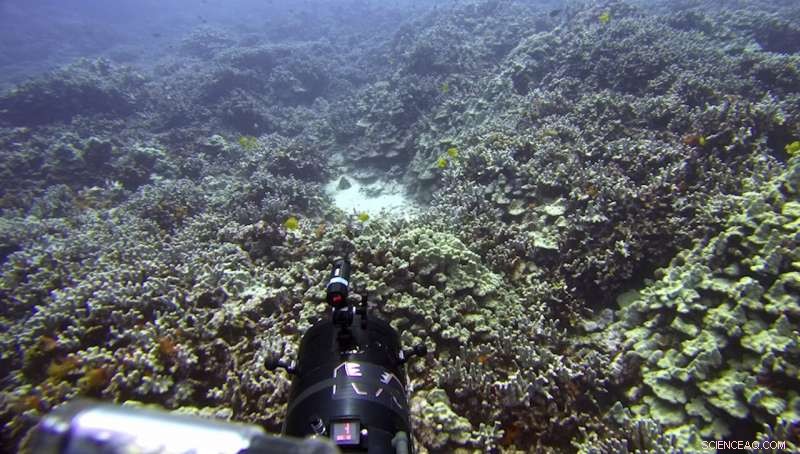
I denna 13 september, 2019 image taken from video provided by Arizona State University's Center for Global Discovery and Conservation Science, ecologist Greg Asner dives over a coral reef in Papa Bay near Captain Cook, Hawaii. "Nearly every species that we monitor has at least some bleaching, " Asner said. (Greg Asner/Arizona State University's Center for Global Discovery and Conservation Science via AP)
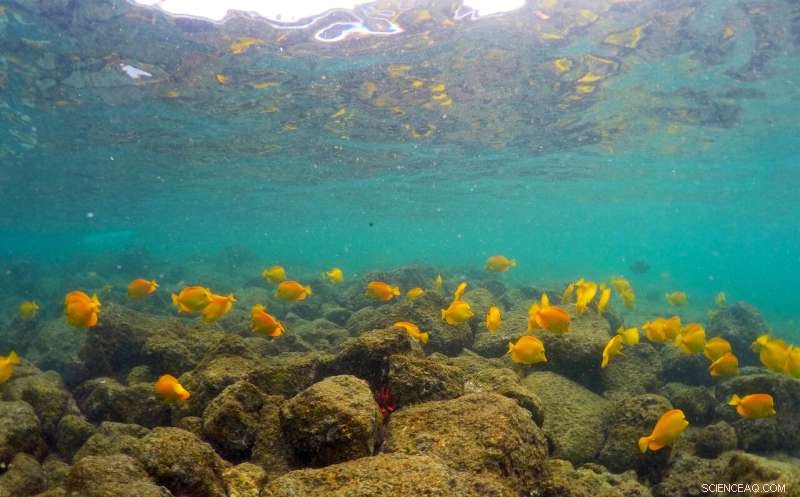
In this Sept. 12, 2019 foto, fish swim near bleaching coral in Kahala'u Bay in Kailua-Kona, Hawaii. Just four years after a major marine heat wave killed nearly half of this coastline's coral, federal researchers are predicting another round of hot water will cause some of the worst coral bleaching the region has ever seen. (AP Photo/Caleb Jones)
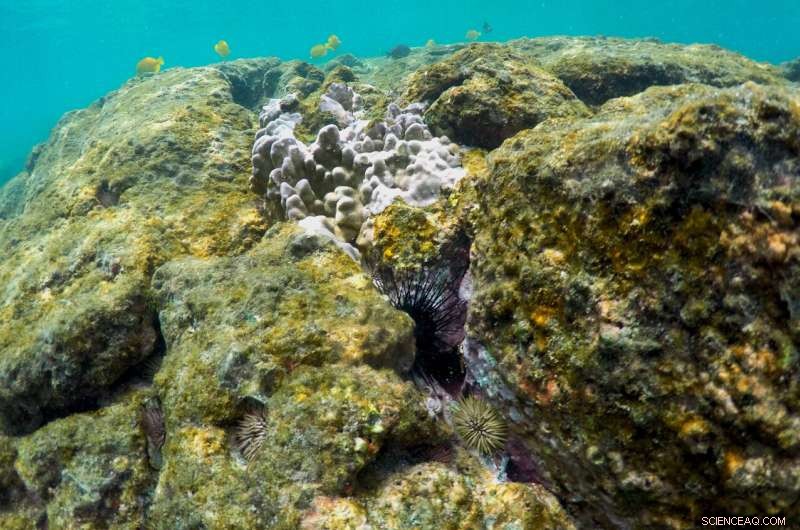
In this Sept. 12, 2019 foto, sea urchins and fish are seen near bleaching coral in Kahala'u Bay in Kailua-Kona, Hawaii. Just four years after a major marine heat wave killed nearly half of this coastline's coral, federal researchers are predicting another round of hot water will cause some of the worst coral bleaching the region has ever seen. (AP Photo/Caleb Jones)
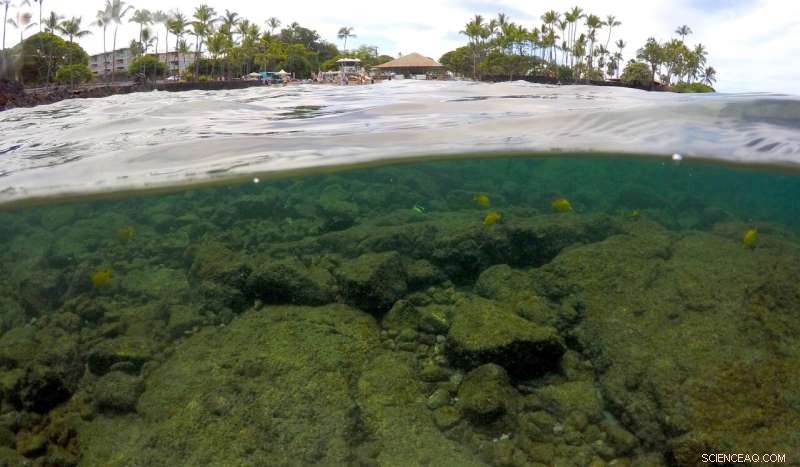
In this Sept. 12, 2019 foto, fish swim near bleaching coral in Kahala'u Bay in Kailua-Kona, Hawaii. Coral reefs are vital around the world as they not only provide a habitat for fish—the base of the marine food chain—but food and medicine for humans. They also create an essential shoreline barrier that breaks apart large ocean swells and protects densely populated shorelines from storm surges during hurricanes. (AP Photo/Caleb Jones)
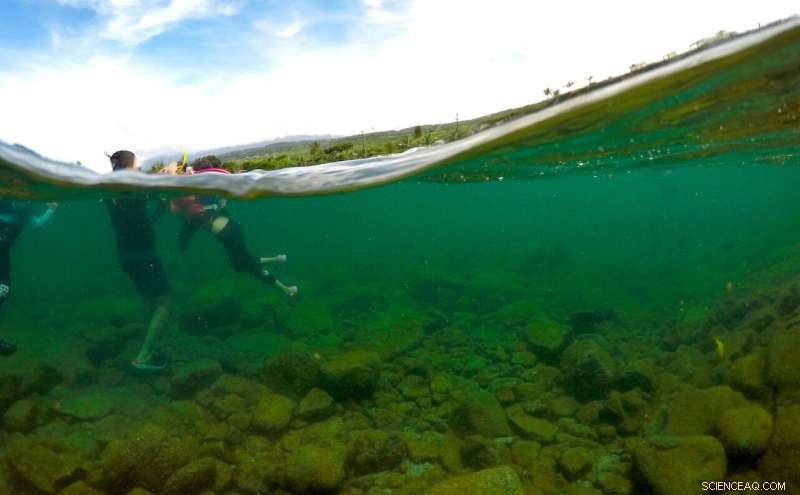
In this Sept. 12, 2019 foto, visitors stand in Kahala'u Bay in Kailua-Kona, Hawaii. Hawaii residents like Cindi Punihaole Kennedy are pitching in by volunteering to educate tourists. Punihaole Kennedy is director of the Kahalu'u Bay Education Center, a nonprofit created to help protect Kahalu'u Bay, a popular snorkeling spot near the Big Island's tourist center of Kailua-Kona. (AP Photo/Caleb Jones)
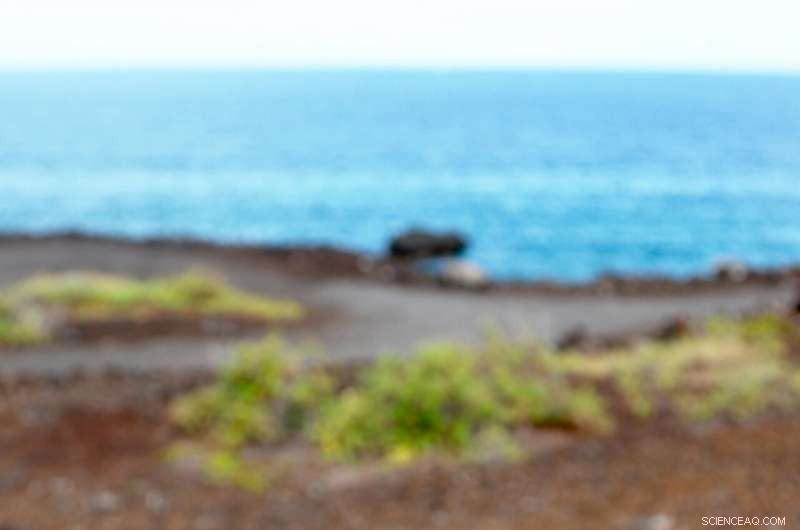
This Sept. 13, 2019 photo shows a chunk of bleached, dead coral shown on a wall near a bay on the west coast of the Big Island near Captain Cook, Hawaii. Coral reefs are vital around the world as they not only provide a habitat for fish—the base of the marine food chain—but food and medicine for humans. They also create an essential shoreline barrier that breaks apart large ocean swells and protects densely populated shorelines from storm surges during hurricanes. (AP Photo/Caleb Jones)
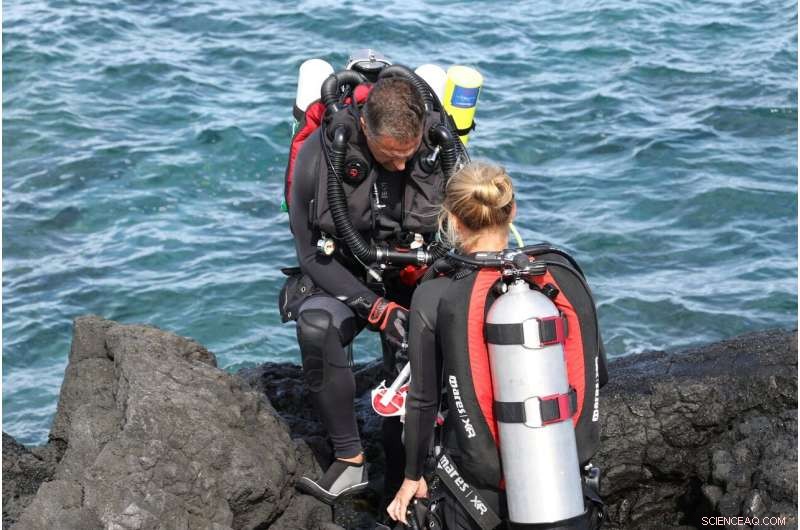
I denna 13 september, 2019 foto, researchers prepare to dive on a coral reef on the west coast of the Big Island near Captain Cook, Hawaii. One of the state's most vibrant coral reefs thrives just below the surface in a bay on the west coast of Hawaii's Big Island. Här, on a remote shoreline far from the impacts of sunscreen and throngs of tourists, scientists see the early signs of what's expected to be a catastrophic season of coral bleaching in Hawaii. The ocean here is about three and a half degrees above normal for this time of year. Coral can recover from bleaching, but when it is exposed to heat over several years, the likelihood of survival decreases. (AP Photo/Caleb Jones)
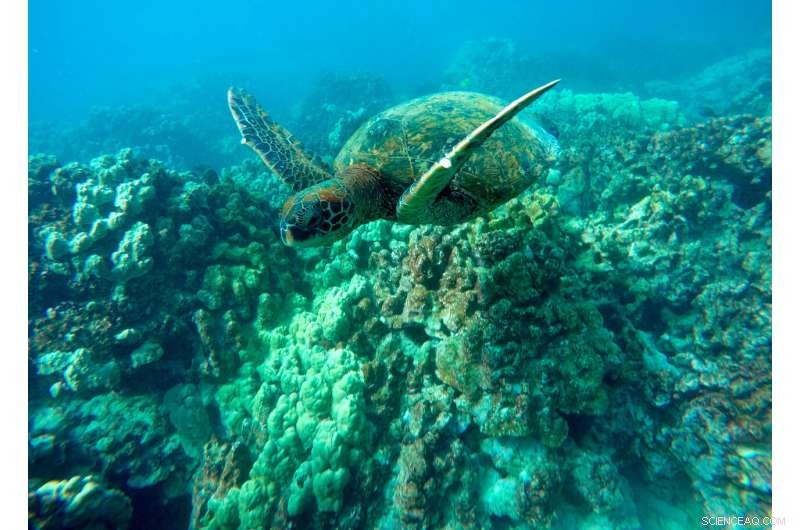
In this Sept. 11, 2019 foto, a green sea turtle swims near coral in a bay on the west coast of the Big Island near Captain Cook, Hawaii. Just four years after a major marine heat wave killed nearly half of this coastline's coral, federal researchers are predicting another round of hot water will cause some of the worst coral bleaching the region has ever seen. (AP Photo/Brian Skoloff)
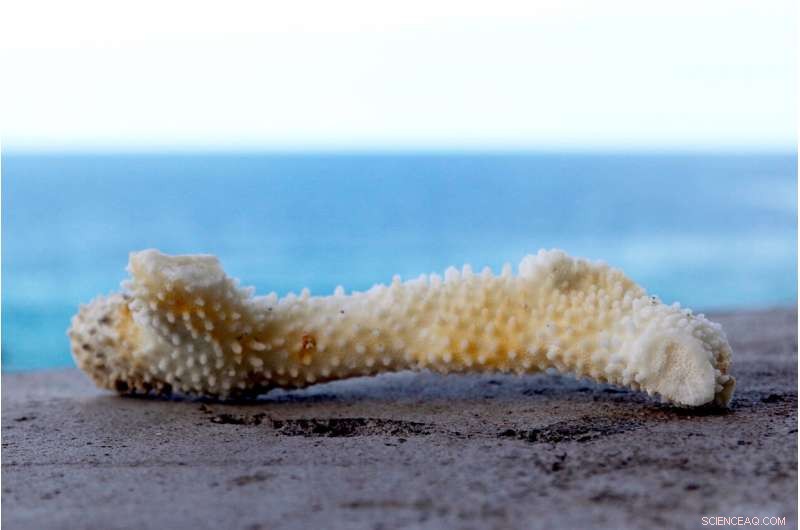
This Sept. 13, 2019 photo shows a chunk of bleached, dead coral shown on a wall near a bay on the west coast of the Big Island near Captain Cook, Hawaii. One of the state's most vibrant coral reefs thrives just below the surface in a bay on the west coast of Hawaii's Big Island. Här, on a remote shoreline far from the impacts of sunscreen and throngs of tourists, scientists see the early signs of what's expected to be a catastrophic season of coral bleaching in Hawaii. The ocean here is about three and a half degrees above normal for this time of year. Coral can recover from bleaching, but when it is exposed to heat over several years, the likelihood of survival decreases. (AP Photo/Caleb Jones)
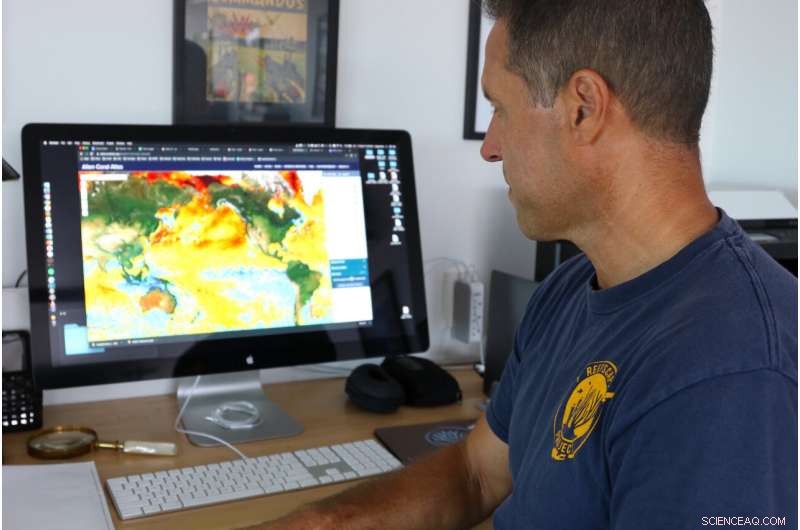
I denna 13 september, 2019 foto, ecologist Greg Asner, the director of Arizona State University's Center for Global Discovery and Conservation Science, reviews ocean temperature data at his lab on the west coast of the Big Island near Captain Cook, Hawaii. "Nearly every species that we monitor has at least some bleaching, " said Asner after a dive in Papa Bay. (AP Photo/Caleb Jones)
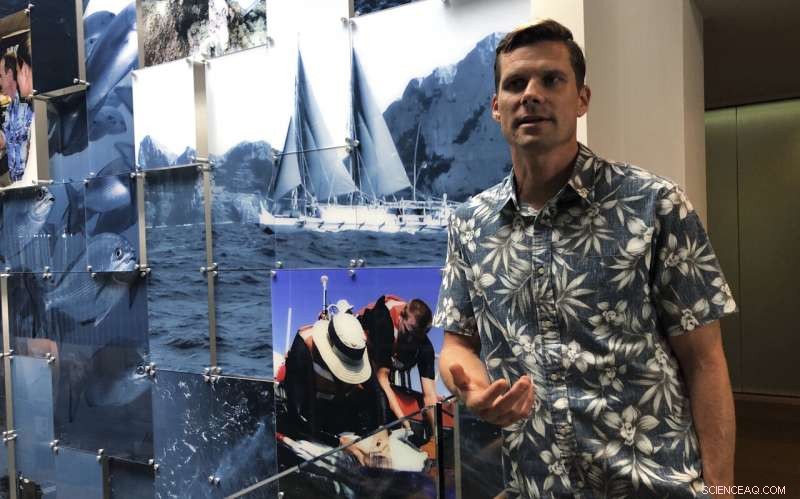
In this Sept. 16, 2019 foto, National Oceanic and Atmospheric Administration oceanographer Jamison Gove talks about coral bleaching at the NOAA regional office in Honolulu. U.S. federal researchers in Hawaii say ocean temperatures around the archipelago are on track to match or even surpass records set in 2015, the hottest year on record for the Pacific Ocean. They predict that heat will cause some of the worst coral bleaching and mortality the region has ever seen. (AP Photo/Caleb Jones)
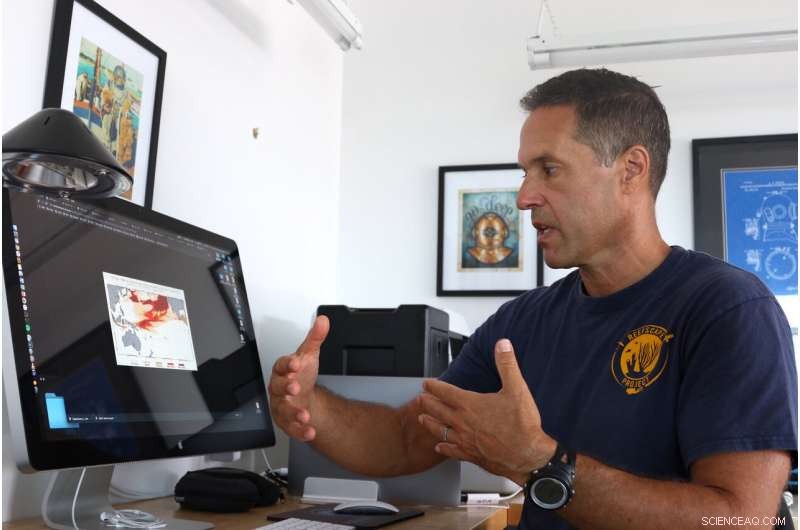
I denna 13 september, 2019 foto, ecologist Greg Asner, the director of Arizona State University's Center for Global Discovery and Conservation Science, reviews ocean temperature data at his lab on the west coast of the Big Island near Captain Cook, Hawaii. "Nearly every species that we monitor has at least some bleaching, " said Asner after a dive in Papa Bay. (AP Photo/Caleb Jones)
The bay suffered widespread bleaching and coral death in 2015.
"It was devastating for us to not be able to do anything, " Punihaole Kennedy said. "We just watched the corals die."
© 2019 Associated Press. Alla rättigheter förbehållna.